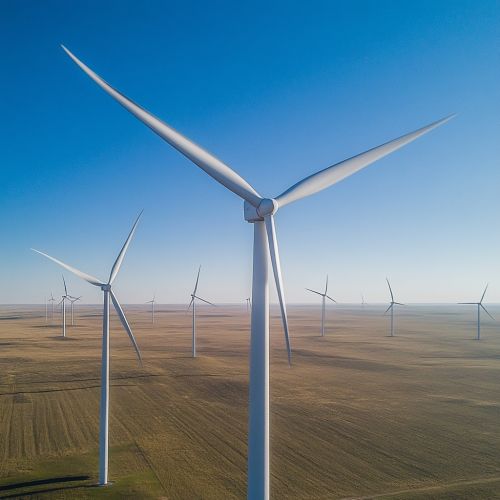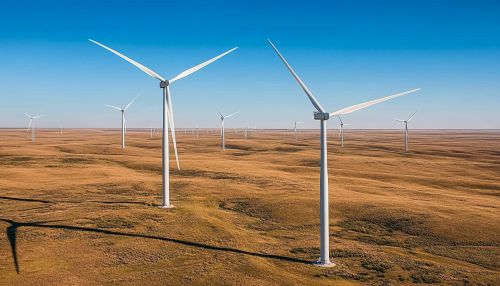Wind power in Kansas
Introduction
Wind power in Kansas has become a significant component of the state's energy portfolio, contributing to both economic growth and environmental sustainability. Kansas, with its vast open plains and consistent wind patterns, is ideally suited for wind energy production. The state ranks among the top in the United States for wind energy capacity and generation, making it a critical player in the national renewable energy landscape.
Geography and Wind Resources
Kansas is located in the central United States, characterized by its expansive flatlands and prairies. The state's geography is conducive to wind energy development due to its unobstructed terrain and favorable wind speeds. The Great Plains region, which includes Kansas, is known for its strong and consistent winds, making it one of the best areas in the country for wind power generation.
The wind resource potential in Kansas is among the highest in the nation. The state benefits from the jet stream and other atmospheric conditions that create a reliable and powerful wind resource. The average wind speed in Kansas is approximately 8.9 meters per second at 80 meters above ground level, which is optimal for wind turbine operation.
Development and Infrastructure
The development of wind power in Kansas has been driven by both state and federal policies aimed at promoting renewable energy. The Renewable Portfolio Standard (RPS) in Kansas, established in 2009, required utilities to generate a certain percentage of their electricity from renewable sources, which spurred investment in wind energy projects.
Kansas is home to several large-scale wind farms, including the Flat Ridge Wind Farm and the Smoky Hills Wind Farm. These projects have been developed by major energy companies and have significantly contributed to the state's wind energy capacity. The infrastructure for wind power in Kansas includes a network of transmission lines that connect wind farms to the electrical grid, facilitating the distribution of wind-generated electricity.


Economic Impact
The wind energy sector in Kansas has had a substantial economic impact, creating jobs and generating revenue for local communities. The construction and operation of wind farms have provided employment opportunities in areas such as manufacturing, transportation, and maintenance. Additionally, landowners who lease their land for wind turbines receive lease payments, which can be a significant source of income.
Wind power has also contributed to the diversification of the state's energy portfolio, reducing reliance on fossil fuels and enhancing energy security. The economic benefits of wind energy extend beyond job creation and income generation, as the industry has attracted investment and stimulated economic growth in rural areas.
Environmental Considerations
Wind power is a clean and renewable energy source that offers significant environmental benefits. In Kansas, the development of wind energy has helped reduce greenhouse gas emissions and decrease air pollution. Wind turbines do not produce emissions during operation, making them an environmentally friendly alternative to traditional fossil fuel-based power generation.
However, the expansion of wind power in Kansas has also raised environmental concerns, particularly regarding the impact on wildlife and natural habitats. The construction and operation of wind farms can affect bird and bat populations, as well as alter the landscape. To address these concerns, developers in Kansas have implemented measures to minimize the environmental impact of wind projects, such as conducting wildlife assessments and designing turbines to reduce collision risks.
Technological Advances
Technological advancements have played a crucial role in the growth of wind power in Kansas. Improvements in turbine design, materials, and manufacturing processes have increased the efficiency and reliability of wind energy systems. Modern wind turbines are capable of generating more electricity at lower wind speeds, making them suitable for a wider range of locations.
The integration of smart grid technology has also enhanced the management and distribution of wind-generated electricity. Smart grids enable real-time monitoring and control of energy flows, improving the efficiency and stability of the electrical grid. In Kansas, the adoption of smart grid technology has facilitated the integration of wind power into the state's energy system.
Policy and Regulation
The regulatory framework for wind power in Kansas is shaped by both state and federal policies. The Kansas Corporation Commission (KCC) is responsible for regulating the state's energy industry, including the approval and oversight of wind energy projects. The KCC ensures that wind farms comply with safety, environmental, and operational standards.
Federal policies, such as the Production Tax Credit (PTC) and the Investment Tax Credit (ITC), have provided financial incentives for the development of wind energy in Kansas. These tax credits have helped offset the costs of wind projects, making them more economically viable.
Challenges and Future Prospects
Despite the success of wind power in Kansas, the industry faces several challenges. One of the primary challenges is the variability of wind energy, which can affect the reliability of electricity supply. To address this issue, energy storage solutions, such as battery storage systems, are being explored to store excess wind-generated electricity for use during periods of low wind.
Another challenge is the need for additional transmission infrastructure to accommodate the growing capacity of wind energy. Expanding the transmission network is essential to ensure that wind-generated electricity can be efficiently distributed to consumers.
Looking ahead, the future of wind power in Kansas is promising. Continued investment in technology and infrastructure, along with supportive policies, will likely drive further growth in the industry. As the demand for renewable energy increases, Kansas is well-positioned to remain a leader in wind energy production.
